Yes,this makes much sense.
The toroids don't have enough inductance on what is now the primary winding to faithfully reproduce any frequency's below what the transformer is rated at.
For instance if the winding is rated at 6v at 60Hz then the most voltage you can excite that winding at 30Hz is 3v.
More voltage than this the core starts into saturation very quickly causing distortion and a severe drop in response.
In my study on "step up transformer design,thread" I had found that but by Quadstacking the cores (adding more iron) seem to reduce the distortion considerably as well, compared to just raising the number of primary turns vs a single core and a lower exciting voltage.
For instance 1 core with 20 turns vs 2 cores 10 turns and the same exciting voltage, the 2 core version had a better quality wave form than the single core at very low frequency's.
And of course more so with 20 turns on 2 cores.
I didn't get too far into this at the time as I was fighting the effects of very large parasitic transformer capacitances loading the amp that I was using.
And I was still learning and I had a lot of things I was trying to figure out all at once.
The Qaudstacked setup gave me a very nice full range but only at a low level but at was at least it was very listenable and was amazing in nearfield on my desktop.
I listened to it for quite some time like this and I hated it when I had to turn the woofer on to listen at a higher level.
I was exploring the sub ranges below 30hz and closer to 15hz,and it took the qaudstacked setup to get fair results at 15hz to 20hz.
But as low as 10hz a single core would not do it hardly at all, no matter how low of voltage I used unless I used a very large number of turns in the winding.
This at the time was working against what I was trying to do.
But what I did seem to notice was that the more iron I used the better the quality of the sine wave I had at such very low frequency's.
I had even tried hooking the transformers 120v windings as a 1:1 using my little sony boxes and this worked great but I did notice a little distortion in the low end as well (even with 640 turns per winding) and that was what that experiment was all about.
The bass just seemed be slightly muddy on the deepest low frequency transits but the over all sound was very good and that is when I started using them for my ESL's.
And, This was when I first started posting.
Had I known what I do now I would have tried hooking up more transformers in parallel to see if this would fix the bass issue.
This something that I will try at a later date to confirm my theory.
And get some THD measurements as well.
So, That was pretty much where I had left off in my study of transformers in 2010.
I hope this gives you a better idea as to why and what is happening.
jer
The toroids don't have enough inductance on what is now the primary winding to faithfully reproduce any frequency's below what the transformer is rated at.
For instance if the winding is rated at 6v at 60Hz then the most voltage you can excite that winding at 30Hz is 3v.
More voltage than this the core starts into saturation very quickly causing distortion and a severe drop in response.
In my study on "step up transformer design,thread" I had found that but by Quadstacking the cores (adding more iron) seem to reduce the distortion considerably as well, compared to just raising the number of primary turns vs a single core and a lower exciting voltage.
For instance 1 core with 20 turns vs 2 cores 10 turns and the same exciting voltage, the 2 core version had a better quality wave form than the single core at very low frequency's.
And of course more so with 20 turns on 2 cores.
I didn't get too far into this at the time as I was fighting the effects of very large parasitic transformer capacitances loading the amp that I was using.
And I was still learning and I had a lot of things I was trying to figure out all at once.
The Qaudstacked setup gave me a very nice full range but only at a low level but at was at least it was very listenable and was amazing in nearfield on my desktop.
I listened to it for quite some time like this and I hated it when I had to turn the woofer on to listen at a higher level.
I was exploring the sub ranges below 30hz and closer to 15hz,and it took the qaudstacked setup to get fair results at 15hz to 20hz.
But as low as 10hz a single core would not do it hardly at all, no matter how low of voltage I used unless I used a very large number of turns in the winding.
This at the time was working against what I was trying to do.
But what I did seem to notice was that the more iron I used the better the quality of the sine wave I had at such very low frequency's.
I had even tried hooking the transformers 120v windings as a 1:1 using my little sony boxes and this worked great but I did notice a little distortion in the low end as well (even with 640 turns per winding) and that was what that experiment was all about.
The bass just seemed be slightly muddy on the deepest low frequency transits but the over all sound was very good and that is when I started using them for my ESL's.
And, This was when I first started posting.
Had I known what I do now I would have tried hooking up more transformers in parallel to see if this would fix the bass issue.
This something that I will try at a later date to confirm my theory.
And get some THD measurements as well.
So, That was pretty much where I had left off in my study of transformers in 2010.
I hope this gives you a better idea as to why and what is happening.
jer
Last edited:
The step up of the toroids (4 per channel) with the primaries in parallel and a .25 ohm resistor on each primary leg (8 resistors in all) and one 1.3 ohm resistor feeding four of the parallel .25 resistors, is about 150:1. Listening to both, the oil burners sound much better in the low bass than the toroids. And measurements of the frequency response seem to back this up. Here is the response of the toroids, which shows a steep drop off after resonance.
With all the primaries wired in parallel each one is receiving the full voltage from your amplifier, so the falling off in response is, as described earlier, due to the low primary inductance of the toroids. As frequency falls, more and more of the audio signal is dropped across the series resistors. They just don't have enough turns on the primary to handle large signals at low frequencies. In fact, as geraldfryjr already mentioned, at low frequencies the cores will begin to saturate which will cause even more voltage drop across the resistors.
Here is some additional information on trying to use power toroids for bass transformers:
http://www.diyaudio.com/forums/planars-exotics/186011-diy-bass-transformer-esls.html#post2520512
The only way to increase the low frequency power handling of the toroids for step-up transformer use is to put some of the primaries in series. Of course this would reduce your overall step-up ratio. Details here(see attachment 4 for wiring):
http://www.diyaudio.com/forums/plan...up-measurements-part-1-2-a-3.html#post2861741
As a sanity check on the practicality of using toroids for bass transformers, if you wanted to be able to handle 200W amplifier at 30Hz without core saturation, and you wanted 150:1 step up ratio, you would need to use about 24 toroids per speaker.
I have a small stock of transformers suitable for bass transformers which would give 150:1 ratio when used in groups of 2. If interested in purchase, send me PM.
Well, it's been a long time since I posted on my ELS project so it's time for an update. I finally got the Laguna tools hollow chisel mortiser which was holding up this project. So I've finished the speaker frames in a Stickley (Mission) style. They are constructed of quarter sawn white oak with sub frames of Douglas pine painted black. Here are a few pictures:

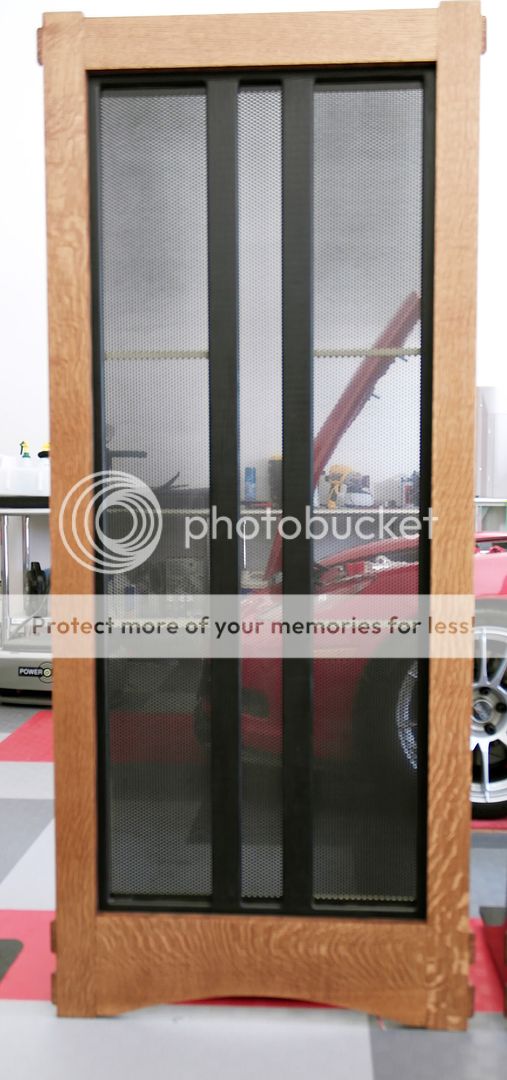
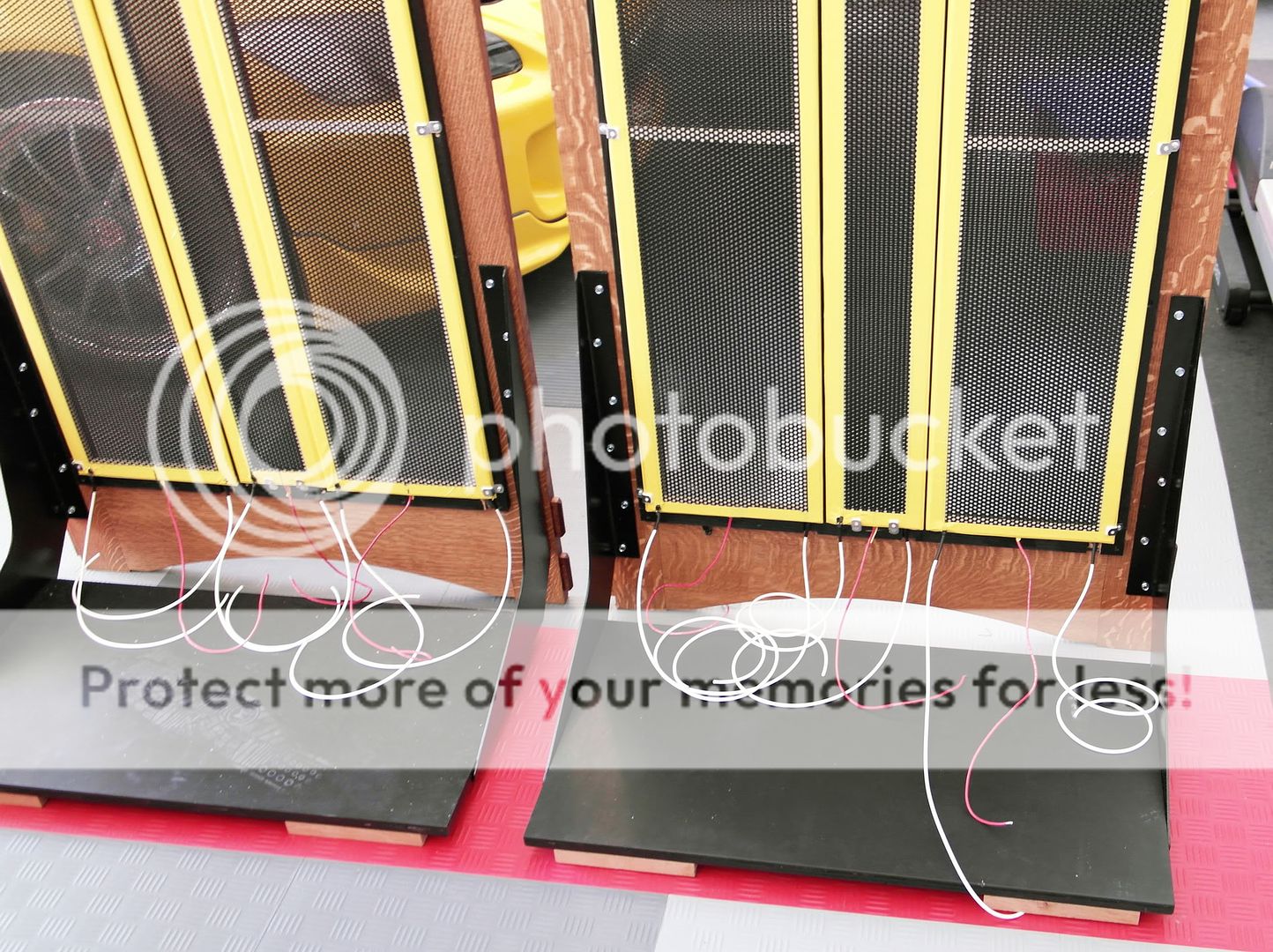
I'm waiting for some sheet aluminum that I ordered to make the case for the electronics. Also need to make some frames for covers for the front and back as we have two cats and I need to keep their hair out. I'll post more as progress is made.



I'm waiting for some sheet aluminum that I ordered to make the case for the electronics. Also need to make some frames for covers for the front and back as we have two cats and I need to keep their hair out. I'll post more as progress is made.
Very nice!
How big are those panels?
Wachara C.
73" tall and 30-1/2" wide.
Another update on my speaker project. Everything is pretty much done except for getting them into the house and doing some testing. I need to determine what crossover frequency to use and the equalization needed to set the Berringer DCX2496 at. I have my daughter and grand kids visiting for the next two weeks so I'll be leaving them in the garage until they are gone. Until then, here are some more pictures:
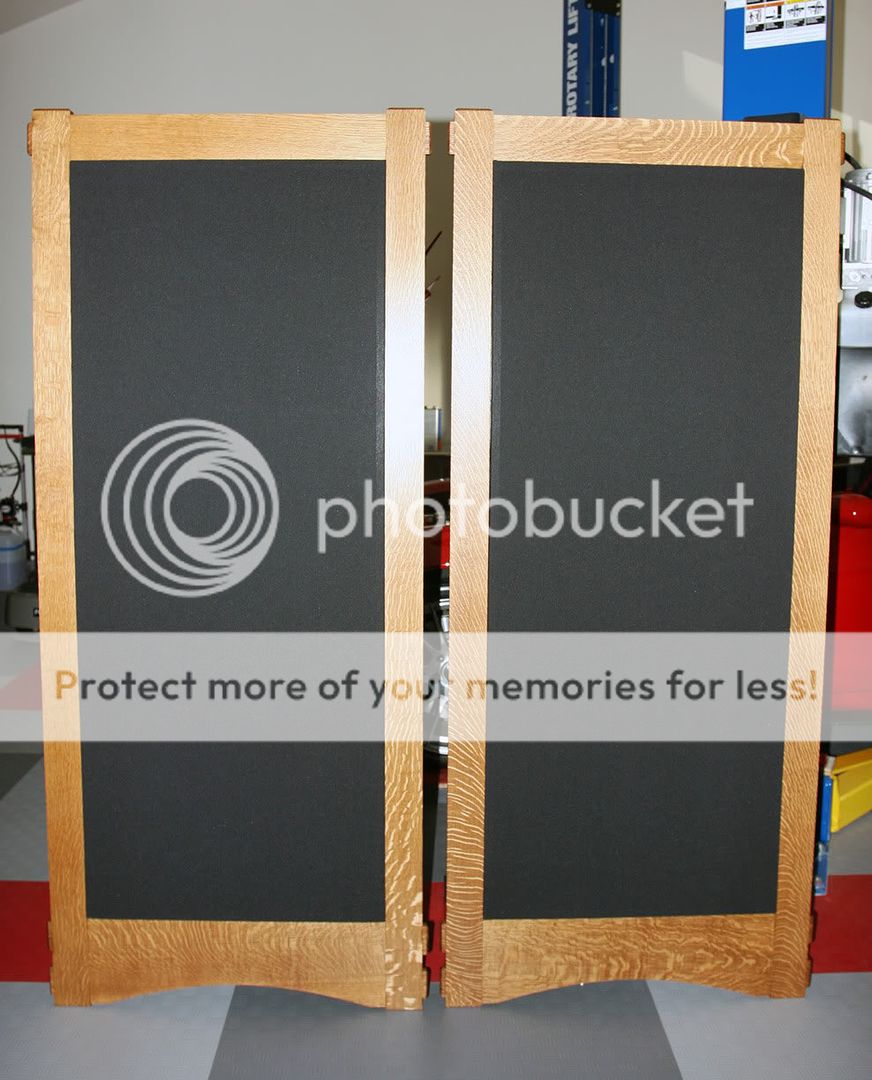
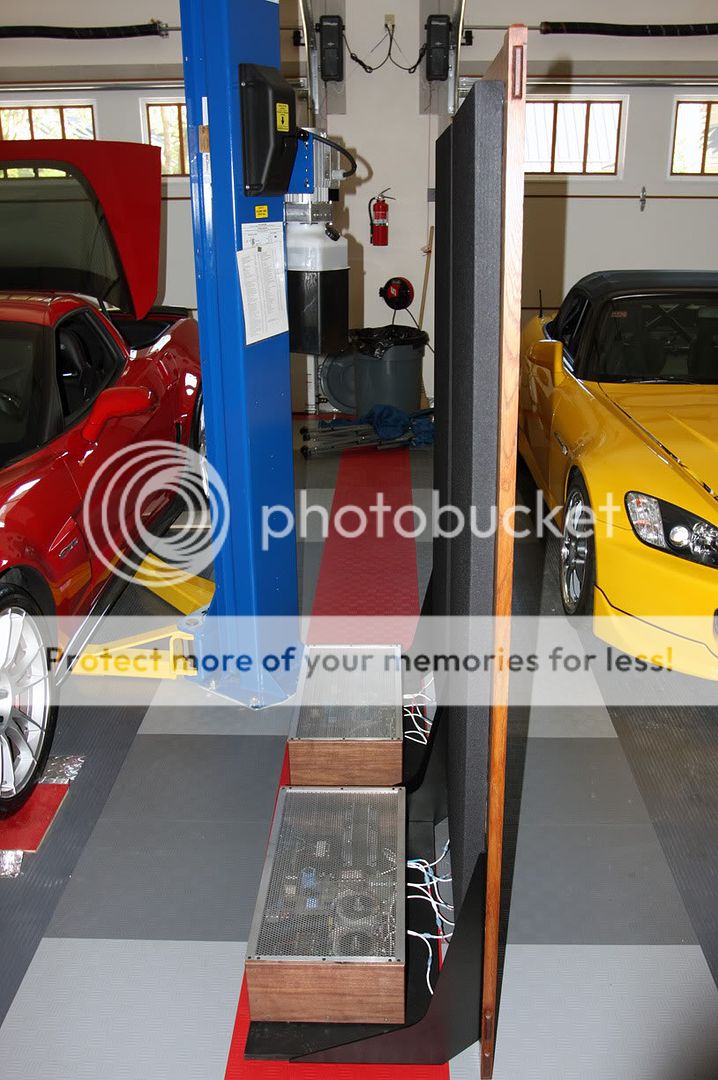
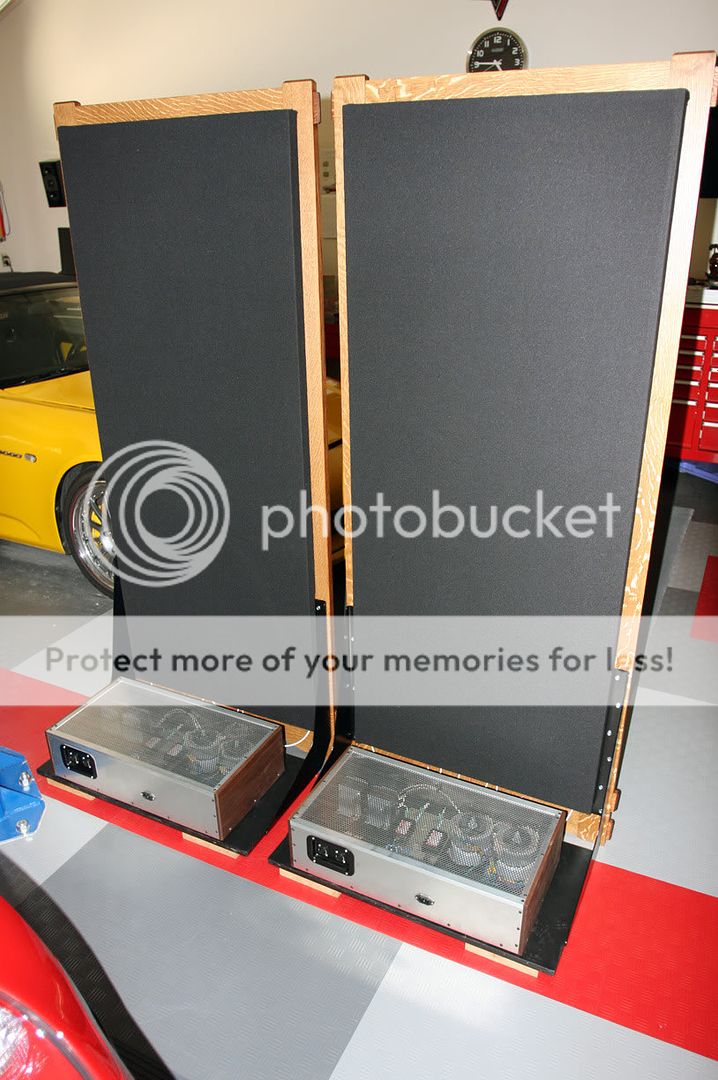
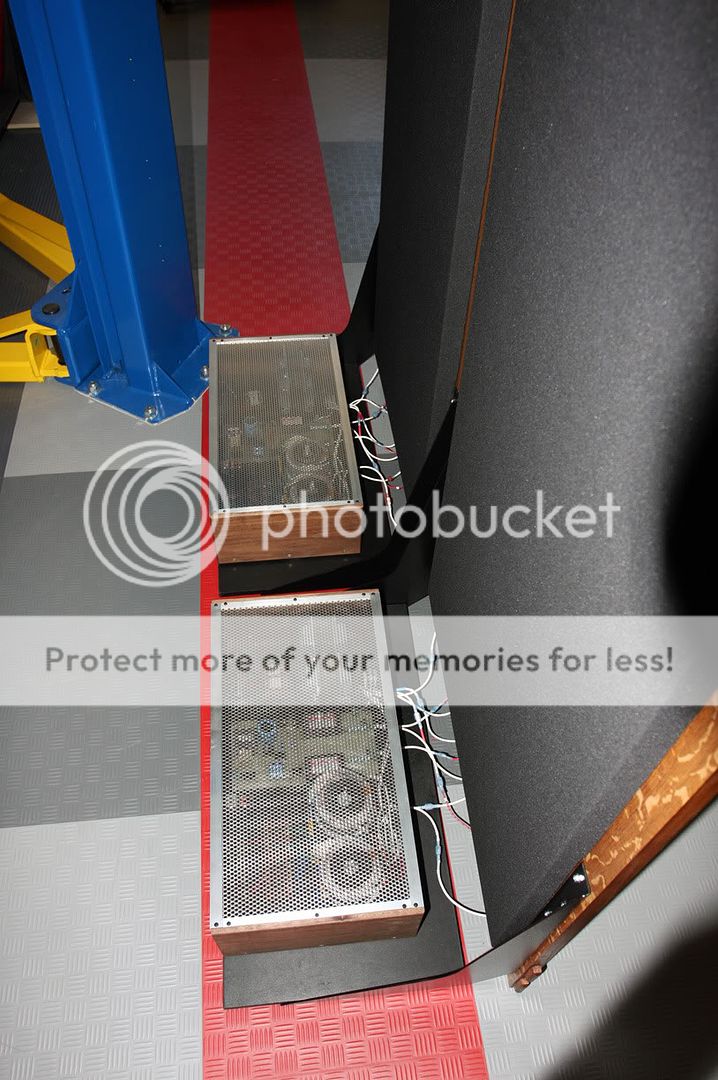
I will probably add a panel to cover the wires in the back so our two cats don't think they are something to play with. Also, I'm thinking about adding some damping material to the back of the two side low end panels but leave the center tweeter panel open. Anyone have any thoughts on this?




I will probably add a panel to cover the wires in the back so our two cats don't think they are something to play with. Also, I'm thinking about adding some damping material to the back of the two side low end panels but leave the center tweeter panel open. Anyone have any thoughts on this?
Me too; all that great speaker design and exceptional esthetics as well.
Love your car lift too.
Final tuning is always to your taste by your ear (nobody who has read threads on the subject here could believe that "flat" is some kind of God ordained virtue).
But first you really have to get a good characterization of the output using trick software that avoids the fallacy of using sine waves in a room.
Do you have good software for mic testing? I use REW from Home Theater: free, good features, and works with Macs. You need a Radio Shack sound level meter (and download the calibration correction curve for it) and away you go.
You might consider testing in a few different rooms (such as garage) and also esp. open air. Run a curve on your amp output when connected to the speakers to ensure that your electric drive is flat (which can be done by just spot checking a few sine-wave freqs... but more fun with REW or other automated plotting).
Which leads next to experimenting with room placement and working with multiple subs in heterogeneous locations.
My Dayton-Wrights are champs for low freq and not bad down to 80 or so... with 40 lb transformers, gas, very big..... Earlier you were aiming for crossing over at like 250? If you can get down low enough to just need subs (120 Hz, no kidding), that would be great.
Ben
Love your car lift too.
Final tuning is always to your taste by your ear (nobody who has read threads on the subject here could believe that "flat" is some kind of God ordained virtue).
But first you really have to get a good characterization of the output using trick software that avoids the fallacy of using sine waves in a room.
Do you have good software for mic testing? I use REW from Home Theater: free, good features, and works with Macs. You need a Radio Shack sound level meter (and download the calibration correction curve for it) and away you go.
You might consider testing in a few different rooms (such as garage) and also esp. open air. Run a curve on your amp output when connected to the speakers to ensure that your electric drive is flat (which can be done by just spot checking a few sine-wave freqs... but more fun with REW or other automated plotting).
Which leads next to experimenting with room placement and working with multiple subs in heterogeneous locations.
My Dayton-Wrights are champs for low freq and not bad down to 80 or so... with 40 lb transformers, gas, very big..... Earlier you were aiming for crossing over at like 250? If you can get down low enough to just need subs (120 Hz, no kidding), that would be great.
Ben
Last edited:
As stated in my last post I won't be able to get around to setting these up in the house and doing some tests for a couple more weeks. In the mean time they are hooked up in the garage to a small 40 watts/channel amp and my Ipod and they sound great. But I have noticed that I'm getting a strong ozone smell from the tweeter panels if I stick my nose right up to them. The large panels are biased to -4500 volts and the small panels are biased at -3500 volts. There is no evidence of arcing and no static or popping noises. Should I be concerned about the ozone?
Ooops. Ozone generation may be very important to address. I hope others will bring their tech diagnostic experience to bear. For example, if it arises from sparking (which might be visible in the dark), not healthy for your diaphragm. (I think Dayton-Wrights in gas bag run much higher voltages.)
I'd just like to say that ozone is damaging for lungs, rubber, etc. when concentrated. But the threshold for smelling it is way below the danger threshold (x10). Good thing, eh.
Ben
I'd just like to say that ozone is damaging for lungs, rubber, etc. when concentrated. But the threshold for smelling it is way below the danger threshold (x10). Good thing, eh.
Ben
Last edited:
Ooops. Ozone generation may be very important to address. I hope others will bring their tech diagnostic experience to bear. For example, if it arises from sparking (which might be visible in the dark), not healthy for your diaphragm. (I think Dayton-Wrights in gas bag run much higher voltages.)
I'd just like to say that ozone is damaging for lungs, rubber, etc. when concentrated. But the threshold for smelling it is way below the danger threshold (x10). Good thing, eh.
Ben
There is no sparking at all. even in total darkness. In order to smell it I need to put my nose right up to the speaker. They will be in the garage for the next few weeks with music playing so we will se what developes. I now have two of my spare QSC amps driving them but still fed from the ipod. And they can play very loud.
Long and hard to follow history on high voltage ion generators and electrostatic cleaners. Suffice it to say, they are definitely out of style today. For the moment.
Take care. Ozone bad and some research says city-living already produces too much ozone exposure. Maybe enclosing speakers is ultimately needed.
And on the other hand, Mike Wright said sound output (for a given input voltage) rises with the square (or more) of the bias voltage. For many ESLs getting enough output matters a lot. I think a sensible trade-off favors conservative bias and bigger drive signal.
Ben
Take care. Ozone bad and some research says city-living already produces too much ozone exposure. Maybe enclosing speakers is ultimately needed.
And on the other hand, Mike Wright said sound output (for a given input voltage) rises with the square (or more) of the bias voltage. For many ESLs getting enough output matters a lot. I think a sensible trade-off favors conservative bias and bigger drive signal.
Ben
Last edited:
Time for an update. In testing the speakers I ran into a problem with one of my large panels not putting out any bass and buzzing at high volume levels. It took a while to figure out the problem, but when I did I felt like an idiot. I forgot to take the protective strip off of one of the foam tape horizontal dividers.
After taking the panel apart and rebuilding it everything is fine now. I have them hooked up to my two spare QSC RMX850 amps with a Beheringer DCX2496 crossover/processor. The crossover is set to 401hz at 48 db/octave and the low frequencys are rolled off at 70 hz at 48db/oct. I've settled on these transformers for the bass:
Transformer - Hammond, Output, Push-Pull, 100 W | Antique Electronic Supply LLC
These are hooked up two per channel, series/parallel. And they work great. Some preliminary testing to adjust the DCX2496 show the frequency response esentially flat from 70 hz up to 20 khz. The speakers sound absolutly wonderful and can play extremely loud.
Once I get them into the house I'll post some more pictures and some plots. I'm a happy camper.
After taking the panel apart and rebuilding it everything is fine now. I have them hooked up to my two spare QSC RMX850 amps with a Beheringer DCX2496 crossover/processor. The crossover is set to 401hz at 48 db/octave and the low frequencys are rolled off at 70 hz at 48db/oct. I've settled on these transformers for the bass:
Transformer - Hammond, Output, Push-Pull, 100 W | Antique Electronic Supply LLC
These are hooked up two per channel, series/parallel. And they work great. Some preliminary testing to adjust the DCX2496 show the frequency response esentially flat from 70 hz up to 20 khz. The speakers sound absolutly wonderful and can play extremely loud.
Once I get them into the house I'll post some more pictures and some plots. I'm a happy camper.
Last edited:
Fperra,
Pics from photobucket are not loading for me. Can you attach them as attachments in a post, so that they remain permanent?
Thanks!
The only way I know how to post pictures is with photobucket. How do I post them as attachments?
- Status
- This old topic is closed. If you want to reopen this topic, contact a moderator using the "Report Post" button.
- Home
- Loudspeakers
- Planars & Exotics
- Some More Questions On ELS Design
